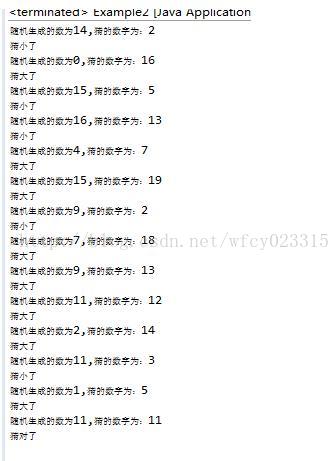题目:
用两个线程玩猜数字游戏,第一个线程负责随机给出1~100之间的一个整数,第二个线程负责猜出这个数。要求每当第二个线程给出自己的猜测后,第一个线程都会提示“猜小了”、“猜大了”或“猜对了”。猜数之前,要求第二个线程要等待第一个线程设置好要猜测的数。第一个线程设置好猜测数之后,两个线程还要相互等待,其原则是:第二个线程给出自己的猜测后,等待第一个线程给出的提示;第一个线程给出提示后,等待给第二个线程给出猜测,如此进行,直到第二个线程给出正确的猜测后,两个线程进入死亡状态。
代码:
package 多线程;
import java.util.Random;
public class Example2 {
public static void main(String[] args) {
// TODO Auto-generated method stub
Thread2 firstTh = new Thread2();
Thread2 secondTh = new Thread2();
boolean flag = true;
while(flag)
{
firstTh.run();
secondTh.run();
if(firstTh.getNum()>100 && firstTh.getNum
()<0)
{
firstTh.notify();
try {
secondTh.wait();
} catch (InterruptedException e) {
// TODO Auto-generated catch block
e.printStackTrace();
}
}
if(secondTh.getNum()>100 && secondTh.getNum
()<0)
{
try {
firstTh.wait();
} catch (InterruptedException e) {
// TODO Auto-generated catch block
e.printStackTrace();
}
secondTh.notify();
}
System.out.println("随机生成的数
为"+firstTh.getNum()+",猜的数字为:"+secondTh.getNum());
if(secondTh.getNum()>firstTh.getNum())
{
System.out.println("猜大了");
}
else if(secondTh.getNum()<firstTh.getNum())
{
System.out.println("猜小了");
}
else
{
System.out.println("猜对了");
flag = false;
}
}
}
}
class Thread2 implements Runnable{
int num;
@Override
public synchronized void run() {
// TODO Auto-generated method stub
Random r = new Random();
num= r.nextInt(20);
}
public int getNum() {
return num;
}
public void setNum(int num) {
this.num = num;
}
}
结果:
